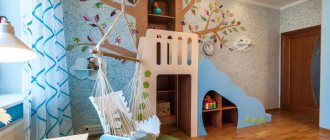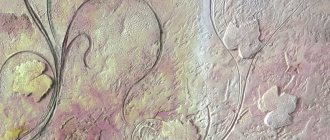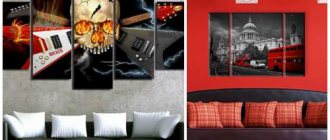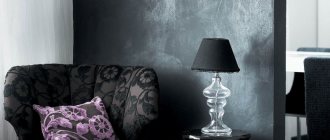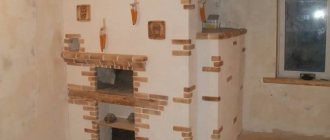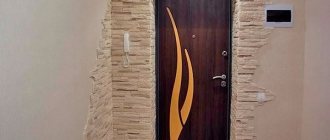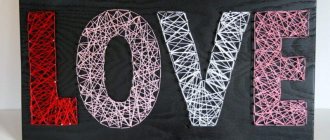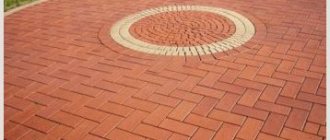If you decide to decorate your space, but don’t know how to make a picture with your own hands, where to go and what to grab, this article was created just for you.
First, you need to decide in which room and on which wall you want to see this decorative element. Enter the room, look around, note for yourself what colors, shades and textures predominate? Is the light warm or cold, how does it fall? What is the mood of this room, how do you feel it?
Already at this moment, some individual ideas, images or color palettes will begin to pop up in your head. At this stage, you can close your eyes and try to imagine a sketch of what you want to see, in as much detail as possible.
The first and most important step has been taken, inspiration has already crept up, all that remains is to call it even closer, and for this you can use various Internet resources, magazines, as well as the works of other authors. Perhaps it is at the moment of looking through the pages or looking at the pictures that the same idea will come to mind.
What to do with the chosen idea?
Suppose the finished picture in the brightest colors has already been drawn in your imagination, but what to do next? And then you should soberly assess your capabilities and abilities, are they enough to accomplish your plans?
If the answer is “Yes,” then you can safely move on to the next point, and if not, then you should think a little and either simplify the idea you came up with, or strive through the thorns to the stars to that very ideal. In any case, everything will definitely work out.
When you are absolutely sure that you can make that very picture with your own hands, you should think about the materials. What should it be made of, what texture?
Think carefully, do not let go of the image from your fantasy and try to touch it and understand what it feels like. Smooth, rough, embossed, soft...
When you have a clear idea of the materials, you can safely purchase everything you need.
Beginning of work
Start creating your canvas with inspiration. There is no need to copy the works of other masters. We advise you to concentrate and think about how you can highlight the mood and dignity of your home. Write down all your ideas in a separate notebook. Consider a place for your future masterpiece.
You also need to decide what style you will work in. Based on it, prepare consumables. It could be:
- any fabric, scraps of leather, as well as ribbons, lace, and so on;
- dried flowers, shells;
- paints and canvas;
- paper, all kinds of clippings, photographs;
- buttons.
In your creativity, you can use children's drawings and a lot of things that at first glance seem like trash. From time to time, audit your “wealth”, and at some point you will feel that you are ready to create an exclusive canvas. After all, the best ideas for paintings for DIY decoration come spontaneously.
What if you have no drawing ability?
Still, this seems more like an excuse used by those who are afraid to experiment and try something new, so think again about whether your hands are really placed so out of place.
- What are reception desks and reception desks for?
- How modern technologies fight bacteria and pollution.
Geology of the site
But if you are still convinced that you have absolutely no creative abilities, don’t give up, there are wonderful options for you too, we will look at them in more detail.
Paints
Using paints is the simplest way to solve the problem. What kind of painting you can make with your own hands depends solely on your imagination.
In your arsenal you can use both regular watercolors and gouache, acrylic or oil paints. The basis can be either plain paper or professional canvas or a board treated with a primer.
Abstractionism
This style of painting will be very simple and advantageous. To create an abstract painting you will need: canvas, paints and brushes. The most important thing is that the colors of the chosen paints combine well with each other.
Next, we give freedom to imagination, pick up paint on a brush and randomly apply it to the canvas in spots, stripes or any fancy patterns. We do this with all the colors, filling the voids and mixing the colors in front of us.
The beauty of this style is that your goal is not to draw something real. You can draw what you like without looking at anything, and if you have any doubts about the beauty of what you draw, remember Malevich’s square and they will disappear.
What you need to create interior paintings
To draw a picture for the interior yourself, you need, first of all, to look at the interior of your home or in the room where you want to place the picture, and analyze whether a picture is needed here? What style and theme of painting would look good here?
And only when you have a rough idea of what could hang on your wall should you start looking for references. You can find many pictures of collections of interior paintings on the Pinterest website - an endless source of inspiration for beginners and experienced artists.
In parallel with the search for ideas and references, start reading about the basic painting techniques and materials that are used in the work: acrylic paints, texture paste, gold leaf, rollers, stamps, large canvases and more.
For the first painting you will need a canvas - the most optimal size is 50x60 cm, but more is possible. The main thing is not to take canvases that are too small. Or, if you prefer, you can take several small canvases and use them to make the modular painting I mentioned above.
Based on the plot of the future work, prepare the appropriate materials: paints (it is better to take acrylic, not oil), brushes, gold leaf, decorative pastes, etc.
It would be a good idea to watch a couple of master classes, both theoretical and practical. Even if you are not afraid of a blank canvas and are ready to paint your masterpiece, it will not hurt you to learn about the properties of paints, the features of decor and its mixing with other materials and other nuances.
Good preparation will save your nerves and help you create a beautiful and neat interior painting for your home!
Painting with threads
To create this picture you will need to put in a little more effort, but the result will pleasantly surprise you. You will need: a board, plywood or a piece of polystyrene foam of a tedious size, small nails, a printed or drawn template of the desired image, a simple pencil.
We place the template on the base, trace it with a simple pencil and drive in nails along the contour at a distance of about 0.5 cm from each other, on one of which we fasten the beginning of the thread and begin to carefully wrap all the nails along the contour.
Advantages and disadvantages of polymer sand tilesHow to waterproof a basement using classic bitumen mastic?
- Multifunctional bedroom
Each module of the picture has its own color. We also fasten the end of the thread to a nail. As a result, we have a very original, beautiful, budget-friendly and easy-to-make painting.
Ideas
Items made with your own hands make up the uniqueness of a home. There are many techniques for creating paintings from the most unexpected materials. Every year new techniques appear that surprise with their originality; many become popular.
See also: Catalog of companies that specialize in the production of finishing and paintwork materials
Button compositions
One of the most obvious is the idea of using buttons. Both adults and children are interested in such creativity. Buttons are considered an ideal material for creating interesting decorative items, varied in color, size and structure. You don't need an art degree to create simple button paintings, and the technique can be learned with a little work to get started.
Butterfly Source avatars.mds.yandex.net
For the base, thick cardboard, a board or canvas stretched over a frame is suitable; You will also need a glue gun and, of course, a scattering of multi-colored buttons. A template is drawn on the blank, and the buttons are laid out on it in the required order. When the position of each of them is determined, you can begin gluing. If necessary, buttons are painted in the desired color from an aerosol can, and additionally rhinestones, beads and beads are used.
Portrait of a pet Source i.pinimg.com
Bunch of grapes Source i.ytimg.com
String art
The name hides an interesting technique that appeared a couple of decades ago. A thread painting is made on a wooden base (light board or plywood), and you will also need small nails, threads and a hammer.
A template is applied to the base, nails are hammered along its contour; it is important that they are at the same height. The thread is attached to the first nail and wrapped around all the others, following the lines of the template. The result is a soft-to-touch, voluminous fabric.
Picture made of threads Source megatyumen.ru
Pictures from wallpaper
A modern trend that suits a variety of designs. Such decor will add originality to the interior, and what is especially valuable, without any special financial investments. Depending on personal preferences and location, you can use different manufacturing techniques, and the finished work can be placed in a frame that suits the style.
For work, use a single piece of roll or a combination using the patchwork technique (from several different fragments) from scraps of wallpaper. You can use your supplies, shout out to friends and relatives, or visit a store that is selling leftover wallpaper.
In oriental style Source i.pinimg.com Idea for an empty wall Source archidea.com.ua
Herbarium painting
Not only will such a homemade painting of flowers be absolutely environmentally friendly, it will also add an atmosphere of light antiquity and autumn comfort.
To create it you will need scissors, a base, glue, various dried leaves, flowers, branches, acorns and pine cones, as well as aged paper, sheet music, scraps from newspapers or books.
We glue notes or scraps of books onto a cardboard base, and glue flowers and leaves on top, leaving small gaps so that the paper can be seen. The paper can be pre-aged in coffee or black tea.
Painting made from down and feathers
To create such a decorative picture, you will need to stock up on beautiful, tinted bird feathers and down or paint them yourself. From them you can lay out any subjects in the form of flowers, where feathers will represent petals, or landscapes, where with the help of feathers and fluff you can create a whole forest or a branch with leaves and fruits.
For greater expressiveness, you can add hard objects with a clear outline to the feathers, for example, buttons or other products made of plastic, wood, as well as pebbles or shells. It is good to frame the painting in a glass frame so that it does not gather dust and does not lose its attractive appearance.
DIY picture frame
Every self-respecting painting should have a frame. This will make this element of decor completely complete, add even more of the desired mood and become a good bright accent.
Making a picture frame with your own hands is quite easy; for this you can use wood, fabric, plastic, foam plastic, plaster, cardboard. The frame can be made from the same materials as the picture, or from contrasting ones, in any case, the result will surprise you.
Briefly about the main thing
Hand-made techniques are a worthy way to exclusively decorate any living space. There are dozens of popular, proven methods that do not require special skills or significant expenses.
Before you start work, you need to find a suitable place for the future panel. The placement location will determine not only the size, but also the color palette of the composition.
You can find an unusual home decor idea online. There you can also get acquainted with the options for using different materials; complex techniques are presented in detail in master classes.
Simple methods include compositions from buttons, seeds and wallpaper patterns. String art and silhouette paintings will take a little more time. A panel of succulents or a lightbox will require attention and knowledge of some features.
Ratings 0
Photos of paintings with your own hands
How to make a modular painting?
A modular painting is a painting in which several canvases contain a single composition. They can be identical or asymmetrical. Such paintings can contain anything, from landscape to abstraction.
It won’t be difficult to choose what you can use to make a modular picture at home. Choose an image that you like. It needs to be enlarged in size and divided into parts (that is, cut). The printed paper or fabric is then fixed onto a suitable base.
If you decide to paint a picture yourself, you should do it on a prepared canvas. If you use paper as a base, we recommend using acrylic or a waterproof marker to write your masterpiece.
A modular painting will look good in any room. The main thing is that the theme matches.
Metal
Writing on copper sheets began in Europe in the 17th century, in Russia - a century later. In our country, sheets for painting were originally made from black iron. In the 20th century, zinc and aluminum came into use by the artist.
It seems that cold metal and warm oil paints are not compatible. But with the right selection of shades, even an unprimed metal surface can be made part of the composition, achieving surreal and original visual effects. There are many artists who paint on metal, and their works are in demand.
Our online store presents paintings painted on high-quality canvases. They do not sag, and the paint layer does not fade if the painting is stored correctly. We offer you to choose a cityscape or any other genre that suits your interior right now.
Should I choose linen canvas?
By choosing a linen canvas, you will repeat the old masters who painted their masterpieces only on linen canvases. Linen has proven itself to be the best material for canvas. Paintings on linen canvases have been painted for centuries, unlike cotton, which appeared as a material for canvas not so long ago. The choice of linen canvas for painting is “noble” and the best among artists.
If we talk about the advantages of linen canvas, it is worth noting:
- linen does not absorb moisture like cotton;
- less susceptible to sagging over time;
- not so susceptible to mechanical damage;
But what about the cons? Are they available when choosing linen canvas? Eat:
- linen canvas is much more expensive than cotton;
- its weight is a little more than cotton (if we talk about exhibitions and sending paintings by mail);

